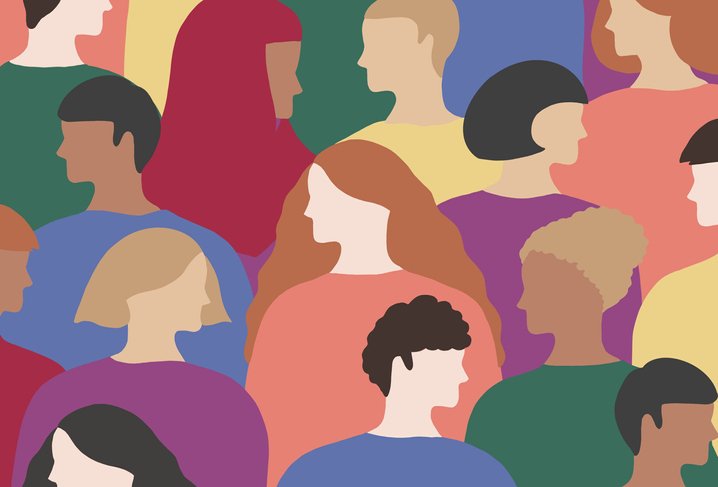Our New Focus
Currently my team and I are working on 25 different projects addressing a variety of challenges ranging from the COVID-19 pandemic to helping Dementia patients stay on track. Each one is important and exciting, and I am thrilled to be tackling so many different projects at once.
One that I am particularly excited about that I wanted to share with you is our current work on creating wearable tech geared towards LGBTQ+ challenges, specifically those of the transgender community.
Approaching a project like this allows you to challenge your assumptions, learn a ton, and potentially do some really impactful work to help solve problems people are facing today.
Like every project I take part in, we approached this one from a standpoint of Design Thinking: empathizing with the participants, defining the problem, ideating on the solution, prototyping, testing, and final assessment.
Empathy

As I’ve detailed in another blog about my design process, empathizing with the intended user of your design is always the starting point. This means asking, “Who will the user be? What are their needs?” Then you start interviewing, surveying, and observing to get a better understanding of what obstacles the user faces and what kinds of technology might make overcoming those obstacles easier.
For this project we began by speaking to members of the transgender community, specifically individuals who identify as trans female, trying to understand in which ways current clothing offerings met their needs and in which ways they didn’t measure up. With any project, especially one where there is a recent explosion of information and opinion, it’s easy to come into it with assumptions about needs and challenges. It’s important to try to put those assumptions aside and focus on empathizing and understanding the needs of your users – without empathy you will be unable to create solutions that satisfy their needs.
Our interviews covered a wide range of topics, but the number one difficulty that we kept coming back to was underwear. The women we spoke to struggled finding underwear that facilitated their gender presentation.
Defining the problem
With our problem identified, it was time to define it. One of my students, Haobo Zhang, really took this concept and ran with it. He did an extensive investigation, clarified background information, conducted market analysis to see what solutions existed and where the gaps were, and formed those factors into an essential understanding of community need.
Among the main elements that we have ultimately focused on in this project are features that replace or stand in lieu of surgical intervention, which is not nearly as common as many might think.
Currently there are few solutions on the market that are able to comfortably compress genitalia sufficiently to present as female. This is a critical concept for this user base, as presentation plays a vital role in a transgender person’s journey towards living comfortably and confidently.
Interviews revealed that in many cases transwomen use tape to compress their genitalia, which presents concerns around effectivity as well as discomfort. Many interviewees also reported using the tucking method to hide genitalia, which can cause health problems. Because neither of these solutions are anywhere close to ideal, we identified this topic as one to investigate and ideate on in the hopes that we could find a better solution.
Aesthetics are a vital part of the equation here, and many of the people we spoke to expressed a desire to have figure enhancements. So many of the women expressed a desire for their undergarments to project femininity, which would help them to feel more like their authentic selves. This information along with preferred colors, materials, and sizing gave us a more complete picture of the problems that needed solving.
Ideation

Data and understanding of need in hand, Haobo designed a collection of 5 underwear styles each with their own innovative features. The ideation step means brainstorming, designing, challenging assumptions in those designs, reassessing your thinking, and designing some more. By expanding your thinking while keeping the four “needs” that all users have (functional needs, aesthetic needs, expressive needs, accessibility needs) in mind, you allow yourself to consider a broad range of concepts, while maintaining focus on the needs of the user, ensuring user acceptance when your designs are eventually produced.
Haobo’s designs are varied in size and use, incorporating different elements of padding to make the garments more comfortable, but also to achieve the desired body shape. Innovate elements include the application of the 5F’s in the design in a way that meets the comfort, cosmetic and health needs of the wearer: Fabric, Fashion, Fit; Function; Fasteners—none were overlooked.
I absolutely love the ingenuity of this design; it takes into account the very real comfort and aesthetic concerns of the end user and provides an elegant solution.
Another collaborator, former student Caitlin Dyes, has taken many of Haobo’s design features and built upon them. Her approach incorporates an overtly sexy and elegant style to appeal to the user’s desire for a more feminine, delicate look. She has also expanded the scope of the work to address top undergarments as well.
Caitlin proposes a number of different material choices and fastener types to help the wearer compress their chest to accentuate the breasts. In combination with her aesthetic design choices, these pieces will address the reported desire of many transwomen to feel “feminine”, “girly”, and to have fun with their clothing. Putting value on the way one feels when donning a piece is critical to creating solutions that the intended user will want to use and be excited about using.
Next Steps
Our process involves thinking, trying, reassessing, and trying some more. The brilliant designs created by Haobo and Caitlin are soon to enter the prototyping phase, where we take the vital step of actually seeing the designs built out. This will allow us to see where they shine, understand limitations, and go back in and address those obstacles.
We’ll be looking for more subjects to interview and gain insight from and volunteers to try on our designs to help improve upon them. The work we’re doing has attracted a lot of attention prompting a youth segment we’ll be starting this fall, in parallel with the current adult themed work.
At this stage a lot is on the table, we have more to learn and discover, and more ways this project can branch out and expand to fit the needs of other populations. It’s an exciting point in the project so stay tuned for future updates on our progress!
About the Team

Caitlin Dyes earned a Bachelor of Science degree from the University of Delaware in 2018, as well as an Associate of Art degree from the Fashion Institute of Design and Merchandise in 2020. She has held countless positions in the apparel industry to include her first job as a merchandising assistant at Giorgio Armani Corporation. Caitlin’s true passion lies in the ability to aid individuals in self-expression and confidence through her designs. Her drive to push the boundaries of fashion led her to continue research and design at the Health Innovation & Design Lab at University of Delaware’s Star Campus. Creating an adaptive denim line for children with disabilities, and functional transgender women’s lingerie are just some of the projects Caitlin has assisted in at the Innovation Health & Design Lab. Caitlin continues to design purposeful user-centered garments that blur the lines of fashion and functionality.


